8/23/2011. I collected a lot of mostly garbage G and B images early on. When I switched to L, I refocused and noticed that even at 1:30 in the morning, after hours of cooling, I was still getting a hot-spot at the top of the PSF.
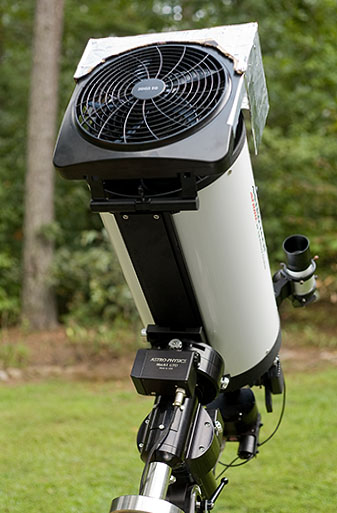 I defocused the images into 15-20 pixel donuts and saw a bright point at the top of every loop. I turned on the fans and all the bright dots promptly disappeared (30 seconds or less). So beyond cooling, the fans do help dispell tube currents when the mirror and the air inside the OTA aren't at equilibrium with the night air.
I defocused the images into 15-20 pixel donuts and saw a bright point at the top of every loop. I turned on the fans and all the bright dots promptly disappeared (30 seconds or less). So beyond cooling, the fans do help dispell tube currents when the mirror and the air inside the OTA aren't at equilibrium with the night air.
I modified the shipping box Amazon used to deliver a 10-inch 12v fan so that it constitutes a mounting bracket to hold the fan over the tube. My expectation is that this fan will pull air up and out of the OTA while the fans behind the mirror push outside air in. [No, people, you don't shoot through the fan; take it off to make photos. Although, I wonder what kind of diffraction images would result... In fact, see below, two days on.] We'll see if using this during twilight cuts into the cooling time, which is now the most time-consuming part of readying the outfit for photogrpahy. Ten minutes to uncover, turn on, synch to the sky, and cool the chip; two hours to cool the mirror and the air inside.
Here are some numbers I may need and which I will never be able to find if I don't write them down somewhere. Like here.
The Peleng 8mm fisheye focuses at infinity at the infinity mark. The 16mm Nikkor full-frame fisheye reaches infinity focus on the Canons using a cheap EOS adapter at or just left of the "0" in the "0.7m" mark. Go figure.
More numbers: Robofocus's temperature sensor read "620" when the evening air was about 77°F. In the wee hours when the air was 20 degrees cooler it said "598." Best focus had moved about 10 RFU's outward. Was that owing to the cooling night or something else? Anyway, if I decide to make use of the temperature compensating features of RoboFocus, there's your first data points.
8/24/2011. What do I know? I think the new fan helped. I used it for half an hour. I think I can't always tell the difference among field rotation, miscollimation, tube currents, seeing, and focus. Maybe I need some sleep. I've been pinging from one diagnosis and fix to another tonight and can't quite settle on a plan to improve everything. The hot spots on each star image are back. Out of focus, they're like diamond rings. I wouldn't care what they look like out of focus ("I usually observe in focus"), but in focus they extend the PSF. This time I treated them as if they were miscollimation. Ambiguous results, maybe slighly worse than ambiguous. I think they really are due to tube currents; that big lump of quartz at the bottom of the stove-pipe gives up heat slowly. If the night cools quickly... tube currents. Next time just restart the fans behind the mirror and don't futz with collimation.
At the beginning of the night, I tried photographing what I am 99% sure are heat plumes by defocusing Arcturus and combining consecutive frames in different channels. Plumes should show up as streaks or areas of color while the defocused donut is a big gray thing. Here are images made 0m, 15m and 30m after using the fans (front and back). All were collected using 5 second exposures throught the Baader H-a filter (try this during a late-night startup when much shorter exposures with the L filter can be used). In each case, I made 3 grayscale images a few seconds apart then channel-mixed those 3 frames in Photoshop (frame 1 becomes the blue channel, frame 2 the green, frame 3 the red) to produce each of the images below:

I decided to try photography through the old Lumicon O-III filter. My first try produced doubled images, then I remembered something from my visual days about red leakage and faux double-stars. At one time, people thought this filter made seeing the companion of Antares really easy; trouble was, it made seeing the companion of every very bright star easy, including those that don't have companions. I double-stacked it with the B filter to trim the red transmission (the G filter should work also: Baader makes hay of the fact that the O-III line falls within the transmission window of both their green and blue filters). That improved the still-hazy image of M27. On to NGC 6888 and 10 minute subs from midnight till until dawn. I have low expectations for this, but tonight's sky is not as good as last night's and it's worth a try. (Got an error message around frame 43, 'cannot poll the camera', but clouds or haze had stopped useful data collection after 26 frames anyway; the error message went away with a software restart.)
That worked OK, but not spectacularly. You have no idea how much I had to pummel the data to get even a little O-III to show up in the mix (and the fact that I'm showing these off small says much about how troubled the images are):
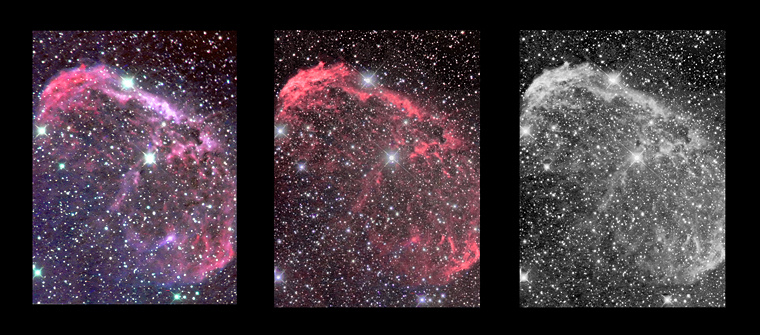
O-III G B L |
L Ha |
L O-III RGB (bw) |
L: 29 300s frames (2h25m)
Ha: 19 900s frames (4h45m)
O-III: 26 600s frames (2h40m)
G: 12x300s (1h)
B: 12x300s (1h)
There's a lot of manual and automatic alignment here, channel mixing, and blend adjustments. Frankly it was something of a free-for-all to find a way for the weak and noisy O-III data to contribute, and my notes aren't good enough to reproduce these images exactly. Only in the O-III channel does that lovely blue "capsule" around the Crescent appear. Also, the dark knot just below the central star is much better seen in O-III than in any other channel. Pulling the dim O-III data up out of the shadows and not allowing it to be overwhelmed by the H-a and L data is tough. Mostly I created a decent b/w rendition from L and Ha and then overlayed a blurred combination of G, B, and O-III. Then boost the B channel in Photoshop. The weights of the color channels to produce a useful frame in Maxim were whacky (.5 5 4 or so) using H-a for R and O-III for B and G for G. Try this again sometime with clearer air and longer O-III subs; the images behind the combined O-III and B filters was very soft for no apparent reason. The Lumicon O-III data was particularly weak with large PSF's and levels all crowded into the left side of the histogram. It's worth more experiments, but one outcome may be that dedicated CCD O-III filters are to be preferred. Thus begins a chain of small considerations that ends with a bigger filter wheel (at least). Cash permitting.
A PTLens defisheyed version of a 16mm frame. The Nikkor full-frame fisheye produces very clean stars. The de-fishing process messed that up some but works well otherwise. Keep it in mind and use as apt:

Backyard Astronomy.
Milky Way starclouds, thin city-lit clouds moving in.
Canon 5D, ISO 1000, 30s at F4
Nikkor 16mm full-frame fisheye
rectified using PTLens.
8/25/2011. About that fan. Yes, you can see through it plenty well enough to polar align and rough focus without interupting its exhausting business. I put a pole out there next to the telescope for polar alignment. No, really. The pole will be used to pry at the trailer on its stone supports to make adjustments in azimuth. That will be easier than trying to crank the little knobs on the Mach1. It's my only nit with the mechanics of the mount: azimuth adjustment is a bitch. Unlock the azimuth binders (which messes with elevation) and then try to develop enough torque to turn those little knobs with 50 lbs of astrograph and 50 more of counterweights sitting down on them while squinting through the bore sight on the other side of the mount. In fairness, A-P has just offered an upgrade to the Mach1 base that probably addresses every one of those complaints. Also in fairness, it's $300. I'm going to try my pole-for alignment method first.
A CCD-assist for azimuth adjustment: aim at a star near the meridian and near the celestial equator. Doesn't have to be a bright star. Put it on the crosshairs in "frame and focus" mode. If it drifts N or S, adjust azimuth until it doesn't. A few seconds of arc in ten minutes is OK. How much to nudge and which way in response to what drift? I dunno. Then do something else to get altitude just so. See notes from experience soon. I thought from tonight, but clouds moved in after twilight.
8/28/2011. Another supernova has gone off in a bright, nearby galaxy. Last night the clear ocean air wrapping in behind Hurricane Irene arrived too late for early-evening imaging, but tonight began clear and I went to work pulling the galaxy and its exploding star out of the twilit NW sky. Here's a first look. I'm too beat to do much more with it tonight. These are a little softer than I'd like; the air is very lively and very clear. I started with a good bit of light left in the sky and finished with M101 less than 30 degrees up in the NW. The tops of pines were beginning to intrude. The same photo appears twice below; the SN is marked in the second presentation:
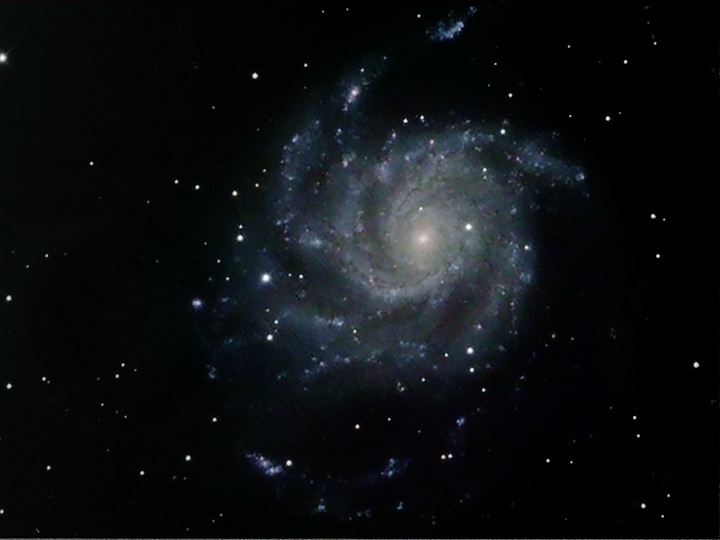
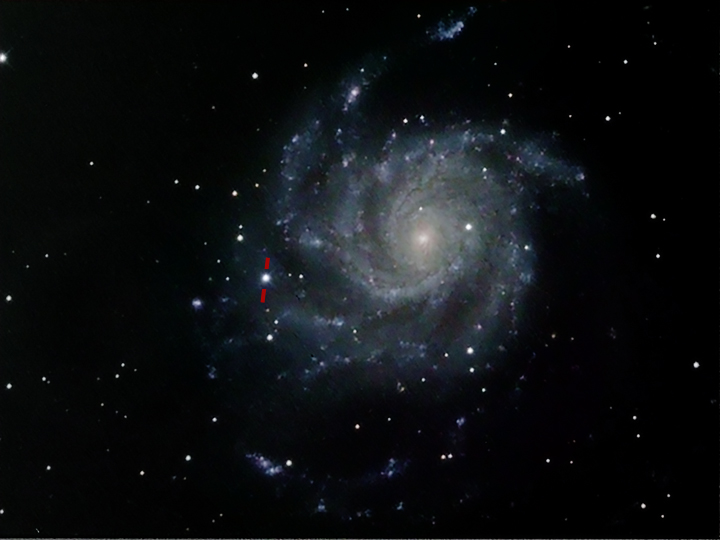
M101 with supernova
18x300s L, 300s RGB
AT10RC, SBIG ST2000XM, A-P Mach1GTO
Baader LRGB filters
Comet Garradd brightening, entering the evening sky:

Comet Garradd
30x60s L
Aligned on the nucleus in Maxim DL
The one minute exposures were chosen with eye on the comet's motion, 2.4 arc seconds per minute, and achieved resolution (FWHM: 2.6 arc seconds). I thought about moving the guide camera from the off-axis guider port to the guide telescope and guiding directly on the nucleus. But I couldn't think of a good reason that the results would be better than digitally aligning the subframes.
Technotes from tonight: I ran the front-mounted fan for two hours before putting the R-C to work and saw no signs of tube currents. While imaging the comet, the fuzz on field stars did not seem quite symmetric, so I think collimation is still just a bit off. Shifting the trailer to make adjustments in azimuth works (how could it not?), and when polar aligning it's perfectly OK to look through the running front-side exhaust fan while watching for drift.
8/30/2011. Back to that clear all day, cloudy at twilight regime. I stole three five minute frames of M101's supernova betwixt clouds. Tonight's seeing is better, focus is better, guiding is better, but I have nothing particularly pretty to show off owing to the clouds and thin data. The images are plenty good enough to measure using Maxim's photometry toolkit. The supernova is 0.7 magnitudes brighter tonight than it was 48 hours ago. Doesn't look like much, but...
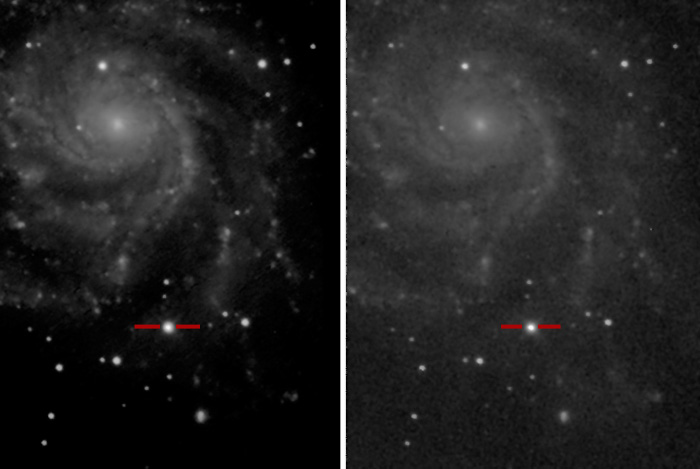
August 28, 2011 August 30, 2011
...note that M101's supernova is about as bright in the right image as in the left, even though field stars are significantly fainter. Using the approximate magnitudes provided by Guide 8 to calibrate measurements made using Maxim DL, I believe the supernova is about magnitude 11.7 in the left image, 11.0 in tonight's. That represents a doubling of the intensity of its light, so if we're looking at a star burning as brightly as a billion suns in the early frame, we're looking at the light of two billion suns in the later one. Doesn't look like much? A fellow ought to be struck dumb by a thing like that.
I did as I have often threatened to do on some marginal night: I aimed the telescope into the rich Milky Way starfields near Sadr and used them to adjust its optical alignment. I took my time and based my adjustments on 9-second exposures of 7th and 8th magnitude stars. I made nearly insensible adjustments using Bob's Knobs. After a dozen or so tweaks, the fuzz was evenly distributed around the bright cores of well-focused star images. FWHM pointspreads shrank by 20% or more. Good deal.
I tried out the newly aligned optics on Comet Garradd, but I lost about every fourth exposure to thickening clouds. The clear interludes were not very. The result is not pretty, and I will spare your bandwidth by not posting it. You're welcome.